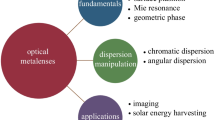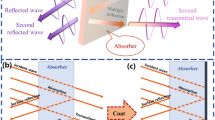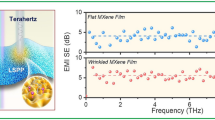Abstract—Layered isotropic structures including layers of metamaterial are considered. Two-layer and multilayer symmetric structures, as well as a structure with a continuous change in material parameters, have been investigated. For the first time, the conditions of transparency of such structures and structures derived from them are presented. It is shown that the boundaries of the regions of no passage of the wave correspond to the conditions of transparency of such structures. It is shown that for transparency parity-time (PT) symmetric structures in electrodynamics and optics, additional conditions are required, in contrast to the structures presented.







Similar content being viewed by others
REFERENCES
M. Born and E. Wolf, Principles of Optics: Electromagnetic Theory of Propagation, Interference, and Diffraction of Light (Pergamon, Oxford, 1964; Nauka, Moscow, 1973).
S. Tretyakov, Analytical Modeling in Applied Electromagnetics (Artech House, Boston, 2003).
K. A. Vytovtov, J. Opt. Soc. Am. A 22, 689 (2005).
P. Yeh, A. Yariv, and C. S. Hong, J. Opt. Soc. Am. 67, 423 (1977).
P. Yeh, A. Yariv, and C. S. Hong, J. Opt. Soc. Am. 67, 463 (1977).
K. A. Vytovtov, in Proc. 35th Eur. Microwave Conf., Paris, France, Oct. 2005 (Paris, 2005), Vol. 2, p. 1359.
K. Vytovtov, E. Barabanova, and S. Zouhdi, in Proc. 12th Int. Cong. AMNWP, Metamaterials. Finland, Espoo. 2018 (AMNWP, 2018), p. 424.
K. A. Vytovtov and A. A. Bulgakov, Telecommun. Radio Eng. 65, 1307 (2006).
L. Mayukh and E. Wolf, J. Opt. Soc. Am. A 30, 2547 (2013).
S. Teitler and B. W. Henvis, J. Opt. Soc. Am. 60, 830 (1970).
D. Saeedkia and S. Safavi-Naeni, J. Lightwave Technol. 25 (1), 432 (2007).
A. Sihvola, S. Tretyakov, and A. de Baas, J. Commun. Technol. Electron. 52, 986 (2007).
F. S. Cuesta, V. A. Lenets, A. Diaz-Rubio, et al., arXiv: 2008.12542 [physics.app-ph].
I. V. Semchenko, I. S. Mikhalka, I. A. Faniayeu, et al., Photonics 7 (4), 83 (2020).
H. Zhao and L. Feng, National Sci. Rev. 5, 183 (2018).
C. E. Rüter, K. G. Makris, R. El-Ganainy, et al., Nature Phys. 6, 192 (2010).
K. G. Makris, R. El-Ganainy, D. N. Christodoulides, et al., Phys. Rev. Lett. 100, 103904 (2008).
A. A. Zyablovskii, A. P. Vinogradov, A. A. Pukhov, and A. V. Dorofeenko, Usp. Fiz. Nauk 184, 1177 (2014).
R. El-Ganainy, K. G. Makris, D. N. Christodoulides, and Z. H. Musslimani, Opt. Lett. 32, 2632 (2007).
I. Liberal, M. Lobet, Y. Li, and N. Engheta, Proc. Natl. Acad. Sci. U. S. A. 117 (39), 24050 (2020).
M. Lobet, I. Liberal, E. Knall, et al., ACS Photonics 7, 1965 (2020).
E. Nahvi, I. Liberal, and N. Engheta, Opt. Lett. 45, 4591 (2020).
K. A. Vytovtov, A. A. Bulgakov, and Yu. S. Tarasenko, in Proc. 11th Int. Conf. on Math. Meth. in Electromag. Theory, (MMET 06) Kharkiv, June 26–29, 2006 (IEEE, New York, 2006).
K. A. Vytovtov and A. A. Bulgakov, in Proc. 2006 Int. Conf. on Microwaves, Radar & Wireless Communications (MICON), Krakow, May 22–24, 2006 (IEEE, New York, 2006).
Funding
The study was supported by the Russian Foundation for Basic Research (project no. 19-29-06043).
Author information
Authors and Affiliations
Corresponding author
Ethics declarations
This study was reported at the Fourth International Youth Conference “Information and Communication Technologies: Modern Achievements” (Astrakhan, October 5–7, 2020).
APPENDIX
APPENDIX
The condition for the transparency of an isotropic structure is the equality of the field components at its output to the field components at its input:
Further, given that the components of the fields at the output of the structure can be obtained using the transformation operator matrix as
we obtain equation
Let us write (A.3) in scalar form
Expressing from second equation (A.4)\({{H}_{{y0}}},\) substituting it into the first equation in (A.4) and performing simple algebraic transformations, we obtain
Taking into account that the transformation matrix of an isotropic structure is always unimodular [1, 3], that is, \({{L}_{{11}}}{{L}_{{22}}} - {{L}_{{12}}}{{L}_{{21}}} = 1,\) we obtain the final expression that determines the transparency condition for the layered isotropic structure:
In this case, any phase shift, even with equal field amplitudes at the input and output, indicates the opacity of the structure, since the phase shift will lead to a rotation of the polarization plane.
Rights and permissions
About this article
Cite this article
Vytovtov, K.A., Barabanova, E.A. & Vishnevsky, V.M. Transparent Multilayer Electromagnetic Structures Based on Metal Metamaterials. J. Commun. Technol. Electron. 66, 1221–1228 (2021). https://doi.org/10.1134/S1064226921110115
Received:
Revised:
Accepted:
Published:
Issue Date:
DOI: https://doi.org/10.1134/S1064226921110115




